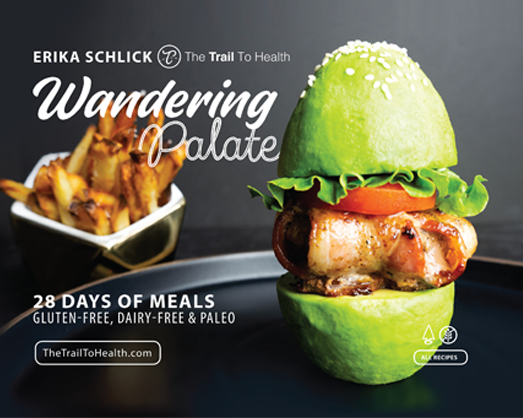Toxins And Antinutrients In Food - Why You Should Avoid Them
/Over the past couple of years, there has been a growing discussion about the toxins and antinutrients in food. Waking up to the potential health threats in our diet, people are now reading food labels, learning more about food sources, and taking steps to keep their kitchen clear of harmful toxins chemicals. So, what are antinutrients in food and should you avoid them?
Keep reading to find out what antinutrients are harmful, and which ones to avoid.
What Are Antinutrients?
If you ask most people what an antinutrient is, they likely won't know. That's because they are discreetly placed in certain foods. As you might guess from the name, they are essentially the opposite of nutritious.
Antinutrients are plant compounds that reduce the body's ability to absorb essential nutrients. Since plants can't run from predators, antinutrients are essentially their self-defense mechanisms.
Grains, legumes, beans, nuts, vegetables, and fruits are the prime ingredients containing antinutrients. However, they can also affect the absorption of nutrients from other foods eaten at the same time!
Eating antinutrients is harmful to healthy people, but it can have severe consequences for the immunocompromised.
So, what are the most common antinutrients found in food?
Lectins
Lectins are proteins that can wreak havoc on your digestive system. When consumed, they disrupt the small intestine's ability to metabolize food. That's because they permanently attach themselves to the walls of your gut. Ultimately, this damages your gut villi, the little hairs that line the inside of your small intestine and absorb nutrients from food.
An influx of bacterial overgrowth occurs, and what follows is an onslaught of gastrointestinal problems from inflammation to leaky gut syndrome. Those sensitive to lectins may also experience joint pain, brain fog, skin issues, and migraines.
While red kidney beans and soybeans contain the most lectins, they can also exist in wheat and peanuts. Most nightshades like potatoes and tomatoes contain lectin, but you can eliminate most with heat from cooking.
People's sensitivity can vary, so try a test diet of foods containing lectin and see how your body reacts to each one. If you have Celiac or gluten intolerance, you may also be susceptible to symptoms caused by plant lectins.
It's important to note that the more lectins you eat, the more damage your body experiences. So no matter what your sensitivity level is, you should avoid eating lectins daily.
Phytates
Phytic acid, also known as phytates, is one of the most infamous antinutrients. As a plant defense against predatorial insects and animals, phytates block mineral absorption of highly necessary nutrients like magnesium, zinc, calcium, and iron.
When you're deficient in these nutrients, a multitude of health problems can occur, including weak bones, fatigue, or a decreased immune system.
Phytates primarily exist in whole grains, nuts, soybeans, and seeds. Cooking these foods in water or soaking them in something acidic like lemon juice can reduce phytates. This will not eliminate all of them, so many grains and seeds may still irritate your gut even after being cooked.
For those who eat red meat regularly, deficiencies caused by phytates are not as big of a concern. While humans, chickens, and pigs do not have the gut bacteria necessary to break down phytates, cows and sheep do. So, to help minimize the damage phytates cause, stick to eating grass-fed beef.
Oxalates
I hate to be the bearer of bad news, but those tasty spinach and kale green smoothies you love may be causing more harm than good.
That's because cruciferous (raw) vegetables contain the antinutrient oxalic acid. Food sources include:
Kale
Chard
Spinach
Buckwheat
Black pepper
Parsley
Poppy seeds
Rhubarb
Amaranth
Beets
Chocolate
Most nuts
Beans
Oxalates bind with the calcium in your body and create sharp little crystals that can harbor in your joints and muscles, causing kidney stones and muscle pain.
For those sensitive to oxalates, even small quantities can cause burning in the ears, eyes, mouth, and throat. In large doses, oxalates can cause muscle weakness, nausea, vomiting, and diarrhea.
Like phytates, you can reduce oxalates through cooking with water or soaking them in citric acids. So while you can still consume cooked greens with relative safety, you should avoid eating them raw.
Mycotoxins
Also called mold toxins, mycotoxins are a big one to avoid. Why? Because most people are exposed to low doses of mycotoxins with every meal since they commonly grow on cereals, dried fruits, nuts, and spices.
Mycotoxins are toxic compounds that exist naturally in certain varieties of mold.
However, 28% of the population has a genetic mutation that prevents your body from detoxing the mold it consumes. Exposure to mold in food or our environment causes major issues that run the gamut, from brain fog, inflammation, anxiety, to intense sugar cravings.
Bottom line: mold is everywhere, and it's toxic.
Mold makes your immune system more sensitive to gluten's damaging effects and can trigger Hashimoto's Disease, an autoimmune disease that compromises the thyroid. It can also exacerbate preexisting food allergies and other autoimmune issues.
Mycotoxins in Coffee
One of the most common carriers of mycotoxins is coffee. Even expensive, organic coffees can contain mold because the beans are often left outside. Have you ever had coffee with an unpleasantly bitter taste? Do you experience an energy crash, jitters, headache, or achy joints after finishing a cup? Then you've probably had moldy coffee.
There are two coffee brands I trust because each one actively tests for mold: Bulletproof Coffee and Purity Coffee.
Dave Asprey, the founder of Bulletproof Coffee, started researching coffee production after he experienced several of these symptoms himself. He discovered that 90% of coffee in Brazil tested positive for mold. Since the U.S., Canada, and the European Union have no regulations for moldy coffee, the beans are imported to the U.S. after other countries reject them. Conversely, South Korea, and Japan have safety protocols in place, so they tend to have safer coffee.
To offer people a mold-free caffeinated alternative, Asprey launched Bulletproof. Their coffee is lab tested and goes through strict processing to ensure there is zero mold present. If you follow my travels on Instagram, you've likely seen that I take Bulletproof Coffee or Purity Coffee on every trip. These are the two brands I trust because they are the only ones that test for mold, so I know I don’t have to worry about being exposed to moldy coffee beans. Purity Coffee is the only other brand I know that also tests for mycotoxins and also brews a delicious cup of coffee so check either one out. Use code TRAILTOHEALTH gets you 20% off and free shipping.
If you want to learn more about Bulletproof's ways of helping immunocompromised people, check out my article on my experience with the Bulletproof Diet.
Unfortunately, mold is not only in coffee. Mold grows on practically every type of plant and can secrete its toxins long before harvest. Mycotoxins can be found in wheat, corn, grains, peanuts, fruits, chocolate, and wine (especially red wine). Mycotoxins can even accumulate in cows milk when the animals eat contaminated grass.
The most alarming fact about mold is that it's incredibly inconsistent. For example, one batch of coffee or grain can be mold-free, while the next contains mold. Unfortunately, this is mostly why most of us have unexplained fatigue, brain fog, and weakness.
To reduce your exposure to mycotoxins, try to get as close as possible to an essential diet of fresh organic vegetables and lean organic, grass-fed meats.
Aflatoxins
Like mycotoxin, aflatoxins are a mold commonly found in agricultural foods like corn, peanuts, tree nuts, and cottonseed.
Aflatoxin is a potent carcinogen and will attack and mutate your body's cells. Frequent exposure can lead to liver damage or liver cancer, especially for people with preexisting conditions like Hepatitis B.
Aflatoxin helps cancer to develop by targeting a specific gene called p53. This incredibly important gene is nicknamed "the tumor suppressor," because of its ability to halt tumor formation. When aflatoxins destroy p53, nothing is stopping your cells from continuously dividing. They keep growing unchecked, eventually forming tumors.
Your best defense against aflatoxins is to avoid them altogether. If you're unable to do that, be selective about the products you purchase. Avoid buying in bulk, and try to go organic as often as possible.
GMOs & PESTICIDES
If you've been following the conversations surrounding food and agriculture over the past couple of years, you're aware of the dangers of GMOs and pesticides.
Even though the general population has taken a stand against these practices, the government continues to support them. As consumers, it's up to us to make sure we avoid these potentially harmful products.
While pesticides protect crops, they can, unfortunately, harm more than just the "pests" they're targeting. Pesticides can make their way from the field to your house, exposing you to their toxins.
Pesticides are acutely toxic. Their harmful effects can cause long term breathing issues, nausea, vomiting, diarrhea, and headaches. To avoid being exposed to pesticides, buy local, organic produce whenever possible. When buying packaged products, take extra time to read the labels to ensure they contain organic ingredients.
Unlike pesticides, the safety of GMO's is unclear. Many people (myself included) know that they cause a variety of severe health issues.
One of the concerns is that GMO foods have more potential to trigger allergic reactions in people with sensitivities.
I personally never eat GMOs. As someone in remission from Lyme disease and multiple autoimmune conditions, I have to be very careful with the foods I consume. So eating GMO foods is never a gamble I am willing to take, it's simply not worth the risk.
The Bottom Line
As you can see, it's crucial to know what you're putting in your body. Antinutrients are a tricky one because they disguise themselves in healthy foods. We're learning that the effects of these plant compounds are harmful.
Take a look at the things in your pantry and see if they contain any of the toxins or antinutrients I listed. If so, see what happens when you cut them out of your diet for a week or two. If you feel better, you've likely found the culprit to your unexplainable symptoms. Knowledge is power, and when it comes to your body, the more you know, the better you can feed it what it wants!




















